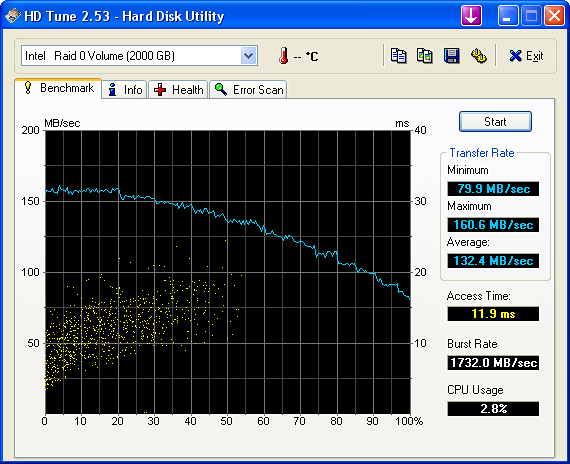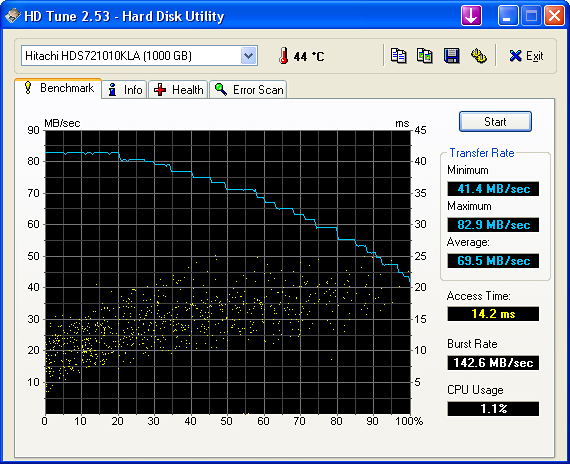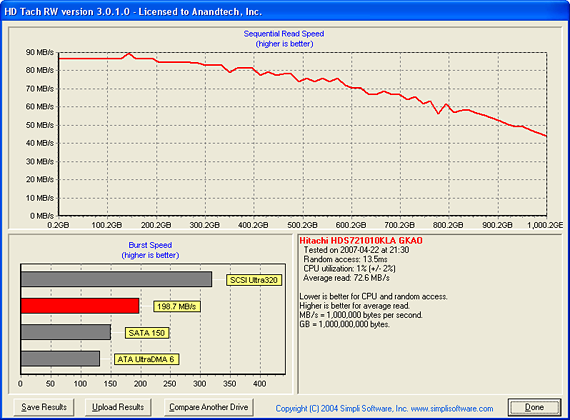Hitachi Deskstar 7K1000: Two Terabyte RAID Redux
by Gary Key on April 23, 2007 12:00 PM EST- Posted in
- Storage
HD Tune 2.53


Our first screenshot is the Hitachi drive with Automatic Acoustic Management turned off, NCQ turned on, and Volume Write-Back cache enabled in RAID 0 operation with the second screenshot showing the same configuration with a single drive. The RAID 0 setup shows a 93% increase in the minimum transfer rate and a 91% increase in the average sustained transfer rate. The maximum transfer rate also increases 95% with the burst rates increasing significantly although in actual operation this number is not completely valid. Turning off the write-back cache setting lowers the burst rate to 144.8 MB/sec. The RAID 0 setup is also reporting improved access times which once again reads 14.4ms with the write-back cache setting turned off.
Hard Disk Performance: HD Tach 3.0


We are also including HD Tach results for review. Once again the order of the screen shots is the same as in our HD Tune results and are based on the same settings. In this benchmark we see a 97% increase in the average read rates and a significant increase in burst speeds over the single drive configuration. These scores basically mirror the HD Tune results with the burst speed dropping to 204 MB/sec with volume write-back cache disabled. While these numbers are impressive, we will have to see if they translate directly to application scores.


Our first screenshot is the Hitachi drive with Automatic Acoustic Management turned off, NCQ turned on, and Volume Write-Back cache enabled in RAID 0 operation with the second screenshot showing the same configuration with a single drive. The RAID 0 setup shows a 93% increase in the minimum transfer rate and a 91% increase in the average sustained transfer rate. The maximum transfer rate also increases 95% with the burst rates increasing significantly although in actual operation this number is not completely valid. Turning off the write-back cache setting lowers the burst rate to 144.8 MB/sec. The RAID 0 setup is also reporting improved access times which once again reads 14.4ms with the write-back cache setting turned off.
Hard Disk Performance: HD Tach 3.0


We are also including HD Tach results for review. Once again the order of the screen shots is the same as in our HD Tune results and are based on the same settings. In this benchmark we see a 97% increase in the average read rates and a significant increase in burst speeds over the single drive configuration. These scores basically mirror the HD Tune results with the burst speed dropping to 204 MB/sec with volume write-back cache disabled. While these numbers are impressive, we will have to see if they translate directly to application scores.










26 Comments
View All Comments
sprockkets - Monday, April 23, 2007 - link
Pic wanted of smoked drive.lplatypus - Monday, April 23, 2007 - link
RAID-0 is not a general solution to improve disk performance. It solves a specific problem: it increases sequential disk bandwidth. If you're not doing sequential disk accesses, then don't expect RAID-0 to help.Of course if your application is doing random disk accesses unnecessarily, then that's a programming problem. But often an application really does need to do random disk accesses.
Advanced filesystems attempt to make common file access patterns translate into sequential disk accesses, so poor RAID-0 performance might be a symptom of a poor filesystem design in your OS. Yet there is a limit to how much the filesystem can produce sequential disk accesses.
yyrkoon - Monday, April 23, 2007 - link
GPU limited HDDs eh ? Come on guys, this statement is starting to sound as though you think using RAID0 in a gaming system is going to increase FPS or something . . . which, we all know is wrong(or should know).
Gee, a Raptor smoking its platters, this aught to quiet those people who think the Raptors are impervious to melt downs. Seriously though, how much was this HDD used ? How old was it ? Personally, I think the answers to both the two questions above, would be worth well more than about 20 AT articles . . . and I must say I rather enjoy reading the articles.
Looking forward to you adding Seagates fastest of their SATA line, and would like to know if you have plans, or would consider testing the NL35 line as well. From what little I have read, the NL35 line are supposed to be geared towards Video, so I would assume the sustained throughput would be higher, but thats why the request for a test of these drives.
nullpointerus - Monday, April 23, 2007 - link
As the article itself says, they did so to answer readers' (IMO ridiculous) objections to the previous RAID article. So you should poke fun at the gamer RAID crowd instead.
yyrkoon - Tuesday, April 24, 2007 - link
That was not my point, I am fairly confident that AT staff doesnt believe this, but it only leads to confusion, for the less tech savvy. I can hear it all over the wanna be 'geek' 'channels' already . . . 'OMG RAID0 increases FPS in <insert first person title name here>, becasue AT said so . . .'. Even though we all know, this is not what was said.SilthDraeth - Monday, April 23, 2007 - link
hopefully our second round of results will answer more questions than it raises answers.johnsonx - Tuesday, April 24, 2007 - link
The last word in that sentence just needs to go away. Then it makes perfect sense: "... answer more questions than it raises."
joex444 - Monday, April 23, 2007 - link
I don't find it confusing, but then again I passed grade 4.vailr - Monday, April 23, 2007 - link
Could you comment on AHCI mode? Comparing enabled in bios vs. disabled?The AHCI "hot swap" feature, for example. Seems to work fine when connected to a SATA JMicron controller, yet DO NOT when connected to an Intel port. On the Gigabyte DS3 board, for one example.
Also: there are newer Intel Inf and Matrix drivers.
Used for this report:
System Platform Drivers:
Intel 8.1.1.1010
Intel Matrix RAID 6.2.1.1002
vs.
Intel Inf Driver Version 8.4.0.1010 Beta
http://www.station-drivers.com/page/intel%20chipse...">http://www.station-drivers.com/page/intel%20chipse...
Matrix Storage Manager drivers version 7.0.0.1020 WHQL
http://www.station-drivers.com/page/intel%20raid.h...">http://www.station-drivers.com/page/intel%20raid.h...
DigitalFreak - Monday, April 23, 2007 - link
AT yet again proves the RAID-0 freak'tards wrong.